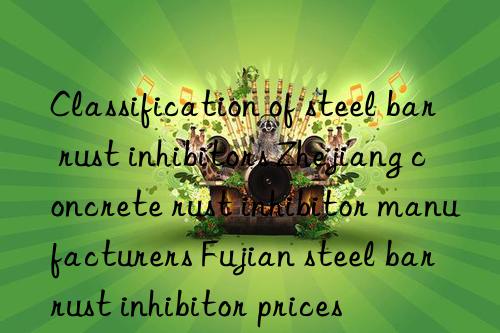
Rebar rust inhibitors refer to chemicals that are added to concrete or painted on the surface of concrete to prevent or slow down the corrosion of steel bars. Some additives or external coating protective agents (such as silica fume, silane impregnating agents, etc.) that can improve the protective performance of concrete on steel bars do not belong to the category of steel bar rust inhibitors. Steel bar rust inhibitors must be able to directly prevent or delay the corrosion of steel bars. The rust inhibitors currently on the market mainly fall into the following categories:
(1) According to usage methods and application objects
Incorporation type (DCI): mixed into concrete, mainly used for new construction and repair projects.
Penetrating type (MCI): Sprayed on the outer surface of concrete, mainly used for the repair of built projects.
(2) According to form
Aqueous dosage form: Foreign products are mainly aqueous dosage forms.
Powder type: Domestic products are mainly powder type.
(3) According to chemical composition
Inorganic type: the ingredients are mainly composed of inorganic chemicals Material composition
Organic type: the ingredients are mainly composed of organic chemicals Mixed type: composed of organic and inorganic chemicals
(4) According to the principle of action
Anodic type: Corrosion of steel bars in concrete is usually an electrochemical process. Substances that can prevent or slow down the anode process are called anodic rust inhibitors. Typical chemicals include chromate, nitrite, molybdate, etc. They can form a "passive film" on the surface of the steel bar. In the early days, nitrite was commonly used as the main component of steel bar rust inhibitor. The disadvantage of this type of rust inhibitor is that when the chloride ion concentration reaches a certain level, it will cause local corrosion and accelerated corrosion, and is called a "dangerous" rust inhibitor. In addition, this type of rust inhibitor has disadvantages such as causing cancer, causing alkali aggregate reaction, and affecting slump, so it is rarely used as a rust inhibitor.
Cathode type: A substance that can prevent or slow down the cathode process by adsorbing and forming a film. Such as zincates, certain phosphates and some organic compounds. Although this type of substance is not dangerous, when acting alone, its effectiveness is not as obvious as the anode type.
Hybrid type: A comprehensive rust inhibitor that reasonably combines cathode type, anode type, resistance-increasing type, oxidation-reducing type, and other substances.
(5) Classification by product
Rust inhibitors containing nitrites ( Calcium Nitrite; Sodium Nitrite, etc.), such as DCI series, Postrite series, etc.
l Rust inhibitors containing aminoalcohols (Aminoalcohols; Dimethylamino-ethanol, etc.), such as SiKaFerrogard series, MCI2000 type, etc.
l Contains aminocarboxylic acid rust inhibitors (Aminocarboxylates), such as MCI2020 type, MCI2006NS type, etc.
l Contains aminoester rust inhibitors (Aminoester), such as Rheocrete series.
l Contains a combination of organosiloxanes and special inhibitors (Silanes and Corrosion Inhibitors), such as Protectosil CIT.
</p



 微信扫一扫打赏
微信扫一扫打赏
